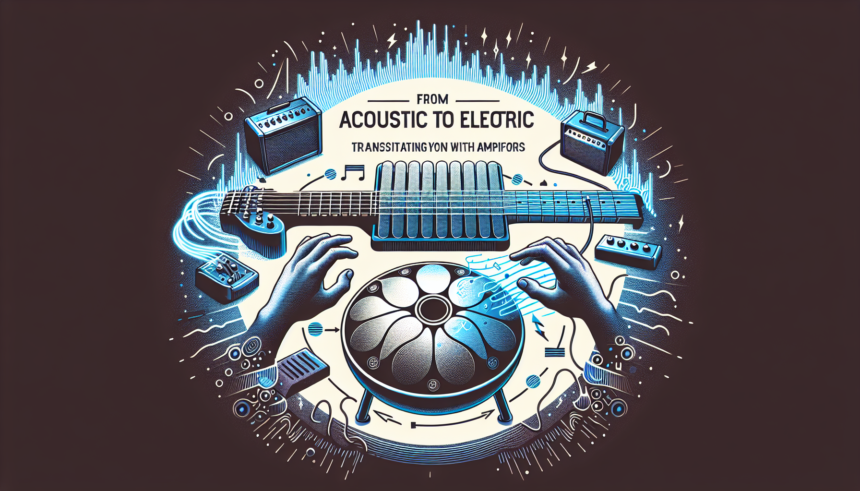The handpan is a mesmerizing musical instrument, known for its ethereal and resonant sound. Traditionally played acoustically, it has found its place in various musical genres, from street performances to intimate studio recordings. However, as the need for higher sound amplification and greater experimental opportunities grows, many musicians are transitioning their handpans from pure acoustic to electric setups using amplifiers. This guide aims to discuss the various aspects and considerations involved in this transition, helping you enhance your handpan’s sonic possibilities.
Understanding the Basics of Handpan Amplification
Amplifying a handpan involves the use of microphones, pickups, and speakers, all connected via an amplifier. This setup not only increases the instrument’s volume but also allows for more significant sound manipulation and integration with other electronic instruments. The process begins with capturing the handpan’s sound accurately and then amplifying and transforming it to suit the performance scenario.
Microphones vs. Pickups
The first step in transitioning to an electric setup is deciding between microphones and pickups. Each has its pros and cons:
- Microphones: Condenser microphones are often preferred for handpans because of their sensitivity and ability to capture the nuances of the instrument. They are typically placed close to the handpan or mounted on stands. However, microphones can pick up ambient noise, which might not be ideal in loud environments.
- Pickups: These are contact microphones that can be attached directly to the handpan. They capture the vibrations of the instrument directly, resulting in a cleaner sound in noisy environments. Piezo pickups are commonly used for handpans. However, they might not capture the full acoustic richness compared to high-quality microphones.
Choosing the Right Amplifier
Once you have decided on your sound capture method, choosing the right amplifier is crucial. Consider the following factors:
- Power: The power rating of the amplifier should match your performance needs. For small gigs, a lower wattage amp might suffice, but for larger venues, a more powerful amp is necessary.
- Controls: Look for amplifiers with built-in equalizers and effects like reverb and delay, which can add depth and texture to your sound.
- Portability: Depending on your movement needs, consider the size and weight of the amplifier. Battery-powered options offer flexibility for street performances and travel.
Setting Up Your Amplified Handpan
Setting up involves connecting your microphone or pickup to the amplifier and adjusting the settings to get the desired sound. Here’s a step-by-step guide:
Connecting the Sound Source
- If using a microphone, connect it to the amplifier using an XLR or ¼” TRS cable.
- If using a pickup, attach it securely to the handpan according to the manufacturer’s instructions and connect it to the amplifier.
- Ensure all connections are secure to avoid signal loss or noise interference.
Adjusting Amplifier Settings
- Volume: Start at a low volume and gradually increase it to avoid sudden loud feedback. Adjust according to the environment and the desired output.
- Equalization (EQ): Fine-tune the bass, mid, and treble settings to enhance the handpan’s natural frequencies. Each handpan is different, so take time to find the perfect balance.
- Effects: Use reverb to add spatial depth and delay to create rhythmic echoes. Experiment with other effects to find what complements your playing style.
Sound Check
Before a performance, always conduct a thorough sound check. Play various notes and dynamics to ensure that the amplified sound is balanced and free from unwanted feedback or noise. Adjust the settings as needed to achieve a clear and pleasant sound.
Recording and Live Performance Tips
Whether you are recording in a studio or performing live, the amplified handpan offers many creative opportunities. Here are some tips to make the most of it:
Recording
- Position the microphone or pickups to capture the best possible sound without compromising playability.
- Use a pop filter with microphones to reduce plosive sounds.
- Experiment with different microphone placements and pickup locations to find the optimal sound capture.
- Use a DAW (Digital Audio Workstation) to further refine the sound with plugins and effects.
Live Performance
- Test the sound system thoroughly before the performance to prevent any technical issues.
- Use a monitor speaker to hear yourself clearly on stage.
- Coordinate with the sound engineer to ensure the handpan’s sound blends well with other instruments.
- Adapt your playing technique to the amplified sound, as nuances might differ from acoustic play.
Exploring Creative Opportunities
The transition from acoustic to electric opens up new creative horizons for handpan players. Here are some ways to explore these opportunities:
Looping and Layering
Using a looper pedal, players can create complex, multi-layered compositions by recording and playing back loops in real-time. This allows for intricate musical pieces that would be challenging to perform solo acoustically.
Effect Pedals
Guitar pedals can be used to add various effects like overdrive, chorus, and phaser. This can transform the handpan’s organic sound into something entirely new and unexpected.
Collaborations
Electric handpans can integrate seamlessly with other electronic instruments, expanding collaborative possibilities. Working with other musicians can lead to unique fusion genres and innovative compositions.
Conclusion
Transitioning your handpan from an acoustic to an electric setup using amplifiers can greatly expand your musical possibilities. From intimate recordings to dynamic live performances, the ability to amplify and manipulate your sound opens up a world of creative opportunities. The key is to understand the tools and techniques available and to experiment with different setups to find what best suits your style and needs. By doing so, you can create a distinctive and impactful musical experience with your handpan, making it an even more versatile and expressive instrument.
FAQs
1. Can I use any microphone with a handpan?
While many microphones can capture the sound of a handpan, condenser microphones are generally preferred due to their sensitivity and ability to capture detailed nuances. However, dynamic microphones can also work well in louder environments.
2. Do I need a special amplifier for my handpan?
No special amplifier is required, but it’s essential to choose one that suits your volume needs and has good EQ and effect controls to enhance your handpan’s sound. Guitar and keyboard amplifiers are commonly used.
3. How do I avoid feedback when amplifying my handpan?
To avoid feedback, start with the volume at a low level and gradually increase it. Position the microphone or pickup correctly, and use a noise gate or feedback suppression tool if necessary.
4. Can I use effect pedals with my amplified handpan?
Yes, effect pedals can be used to add a variety of effects to your amplified handpan sound, allowing for creative experimentation. Commonly used effects include reverb, delay, and chorus.
5. Is it difficult to set up an amplified handpan for live performances?
With practice, setting up an amplified handpan becomes straightforward. Familiarize yourself with your equipment, conduct thorough sound checks, and work closely with the sound engineer to ensure a smooth setup and performance.





